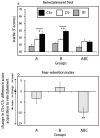Extinction in multiple virtual reality contexts diminishes fear reinstatement in humans
- PMID: 24583374
- PMCID: PMC4053498
- DOI: 10.1016/j.nlm.2014.02.010
Extinction in multiple virtual reality contexts diminishes fear reinstatement in humans
Abstract
Although conditioned fear can be effectively extinguished by unreinforced exposure to a threat cue, fear responses tend to return when the cue is encountered some time after extinction (spontaneous recovery), in a novel environment (renewal), or following presentation of an aversive stimulus (reinstatement). As extinction represents a context-dependent form of new learning, one possible strategy to circumvent the return of fear is to conduct extinction across several environments. Here, we tested the effectiveness of multiple context extinction in a two-day fear conditioning experiment using 3-D virtual reality technology to create immersive, ecologically-valid context changes. Fear-potentiated startle served as the dependent measure. All three experimental groups initially acquired fear in a single context. A multiple extinction group then underwent extinction in three contexts, while a second group underwent extinction in the acquisition context and a third group underwent extinction in a single different context. All groups returned 24h later to test for return of fear in the extinction context (spontaneous recovery) and a novel context (renewal and reinstatement/test). Extinction in multiple contexts attenuated reinstatement of fear but did not reduce spontaneous recovery. Results from fear renewal were tendential. Our findings suggest that multi-context extinction can reduce fear relapse following an aversive event--an event that often induces return of fear in real-world settings--and provides empirical support for conducting exposure-based clinical treatments across a variety of environments.
Keywords: Anxiety; Extinction; Fear conditioning; Fear-potentiated startle; Virtual reality.
Copyright © 2014 Elsevier Inc. All rights reserved.
Figures



Similar articles
-
Reinstatement of contextual anxiety in humans: Effects of state anxiety.Int J Psychophysiol. 2015 Dec;98(3 Pt 2):557-66. doi: 10.1016/j.ijpsycho.2015.07.013. Epub 2015 Jul 29. Int J Psychophysiol. 2015. PMID: 26232063
-
Contextual-specificity of short-delay extinction in humans: renewal of fear-potentiated startle in a virtual environment.Learn Mem. 2007 Apr 5;14(4):247-53. doi: 10.1101/lm.493707. Print 2007 Apr. Learn Mem. 2007. PMID: 17412963 Free PMC article.
-
Renewal of conditioned fear responses using a film clip as the aversive unconditioned stimulus.J Behav Ther Exp Psychiatry. 2019 Dec;65:101493. doi: 10.1016/j.jbtep.2019.101493. Epub 2019 Jun 4. J Behav Ther Exp Psychiatry. 2019. PMID: 31203173
-
Extinction in human fear conditioning.Biol Psychiatry. 2006 Aug 15;60(4):361-8. doi: 10.1016/j.biopsych.2005.10.006. Epub 2006 Feb 28. Biol Psychiatry. 2006. PMID: 16503330 Review.
-
Learning and memory in conditioned fear extinction: effects of D-cycloserine.Acta Psychol (Amst). 2008 Mar;127(3):601-13. doi: 10.1016/j.actpsy.2007.07.001. Epub 2007 Aug 17. Acta Psychol (Amst). 2008. PMID: 17707326 Review.
Cited by
-
Behavioral and neural processes in counterconditioning: Past and future directions.Behav Res Ther. 2020 Feb;125:103532. doi: 10.1016/j.brat.2019.103532. Epub 2019 Dec 12. Behav Res Ther. 2020. PMID: 31881357 Free PMC article. Review.
-
Circuit dysregulation and circuit-based treatments in posttraumatic stress disorder.Neurosci Lett. 2017 May 10;649:133-138. doi: 10.1016/j.neulet.2016.11.014. Epub 2016 Nov 12. Neurosci Lett. 2017. PMID: 27845239 Free PMC article. Review.
-
Single-session gamified virtual reality exposure therapy for spider phobia vs. traditional exposure therapy: study protocol for a randomized controlled non-inferiority trial.Trials. 2016 Feb 2;17:60. doi: 10.1186/s13063-016-1171-1. Trials. 2016. PMID: 26833396 Free PMC article. Clinical Trial.
-
A model for recovery-from-extinction effects in Pavlovian conditioning and exposure therapy.Learn Behav. 2023 Sep;51(3):332-345. doi: 10.3758/s13420-023-00578-0. Epub 2023 Mar 3. Learn Behav. 2023. PMID: 36869186
-
Effects of cortisol on retrieval of extinction memory in individuals with social anxiety.Compr Psychoneuroendocrinol. 2021 May 26;7:100060. doi: 10.1016/j.cpnec.2021.100060. eCollection 2021 Aug. Compr Psychoneuroendocrinol. 2021. PMID: 35757066 Free PMC article.
References
-
- Armony JL, Dolan RJ. Modulation of auditory neural responses by a visual context in human fear conditioning. Neuroreport. 2001;12:3407–3411. - PubMed
-
- Balooch SB, Neumann DL. Effects of multiple contexts and context similarity on the renewal of extinguished conditioned behaviour in an ABA design with humans. Learning and Motivation. 2011;42:53–63.
-
- Balooch SB, Neumann DL, Boschen MJ. Extinction treatment in multiple contexts attenuates ABC renewal in humans. Behav Res Ther. 2012;50:604–609. - PubMed
-
- Bouton ME. Context, ambiguity, and unlearning: Sources of relapse after behavioral extinction. Biological Psychiatry. 2002;52:976–986. - PubMed
-
- Bouton ME. Context and behavioral processes in extinction. Learning & Memory. 2004;11:485–494. - PubMed
Publication types
MeSH terms
Grants and funding
LinkOut - more resources
Full Text Sources
Other Literature Sources
Research Materials

